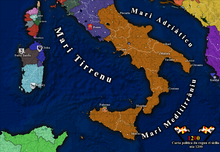
Back Reino de Sicilia AN مملكة صقلية Arabic مملكة صقليه ARZ Reinu de Sicilia AST Siciliya krallığı Azerbaijani Каралеўства Сіцылія Byelorussian Сицилианско кралство Bulgarian Rouantelezh Sikilia Breton Regne de Sicília Catalan Sicilské království Czech
Kingdom of Sicily | |||||||||||||||
|---|---|---|---|---|---|---|---|---|---|---|---|---|---|---|---|
| 1130–1816 | |||||||||||||||
| Motto: Animus Tuus Dominus (Latin for 'Courage is thy Lord') (in use in the Sicilian Vespers of 1282) | |||||||||||||||
 The Kingdom of Sicily in 1190 | |||||||||||||||
 The Kingdom of Sicily and its territorial divisions in the 14th century. | |||||||||||||||
| Status |
| ||||||||||||||
| Capital and largest city | Palermo 38°35′31″N 16°4′44″E / 38.59194°N 16.07889°E | ||||||||||||||
| Official languages | |||||||||||||||
| Religion | Roman Catholicism (official) | ||||||||||||||
| Demonym(s) | Sicilian | ||||||||||||||
| Government | Feudal monarchy | ||||||||||||||
| King | |||||||||||||||
• 1130–1154 | Roger II (first) | ||||||||||||||
• 1266–1282 | Charles I of Anjou | ||||||||||||||
• 1759–1816 | Ferdinand III (last) | ||||||||||||||
| Legislature | Parliament | ||||||||||||||
| History | |||||||||||||||
| 1130 | |||||||||||||||
| 1282 | |||||||||||||||
| 1816 | |||||||||||||||
| |||||||||||||||
| Today part of | Italy Malta | ||||||||||||||

The Kingdom of Sicily (Latin: Regnum Siciliae; Sicilian: Regnu di Sicilia; Italian: Regno di Sicilia[2][3][4][5]) was a state that existed in Sicily and the south of the Italian Peninsula plus, for a time, in Northern Africa from its founding by Roger II of Sicily in 1130 until 1816. It was a successor state of the County of Sicily, which had been founded in 1071 during the Norman conquest of the southern peninsula. The island was divided into three regions: Val di Mazara, Val Demone and Val di Noto.
After a brief rule by Charles of Anjou, a revolt in 1282 known as the Sicilian Vespers threw off Angevin rule in the island of Sicily. The Angevins managed to maintain control in the mainland part of the kingdom, which became a separate entity also styled Kingdom of Sicily, although it is retroactively referred to as the Kingdom of Naples, after its capital. From 1282 to 1409, the island was ruled by the Crown of Aragon as an independent kingdom, and was then added permanently to the Crown. Following the dynastic union of Castile and Aragon in 1479, it was a viceroyalty of the Spanish kingdom. [6][7] During the war of the Spanish succession (1700–1714), the island was taken over by the House of Savoy. In 1720, Savoy gave it to Austria in exchange for Sardinia. Later, the island was ruled by a branch of the Bourbons. Following the Napoleonic period, the Kingdom of Sicily was formally merged with the Kingdom of Naples to form the Kingdom of the Two Sicilies, which in 1861 became part of the new unified Kingdom of Italy.
- ^ Mallette 2011, p. 5.
- ^ Documenti per servire alla storia di Sicilia: Diplomatica, Volumes 14-16 (in Italian). U. Manfredi Editori. 1891-01-01. p. XXXII. Archived from the original on 2024-01-20. Retrieved 2020-10-18.
- ^ Vio, Michele Del (1706-01-01). Felicis, et fidelissimæ urbis Panormitanæ selecta aliquot ad civitatis decus, et commodum spectantia privilegia per instrumenta varia Siciliæ ... opera don Michaelis De Vio . (in Italian). in palatio senatorio per Dominicum Cortese. p. 314. Archived from the original on 2024-01-20. Retrieved 2020-10-18.
- ^ Gregorio, Rosario (1833-01-01). Considerazioni sopra la storia di Sicilia dai tempi normanni sino al presenti, Volume 3 (in Italian). dalla Reale Stamperia. p. 303. Archived from the original on 2024-01-20. Retrieved 2020-10-18.
- ^ Mongitore, Antonino; Mongitore, Francesco Serio e (1749-01-01). Parlamenti generali del regno di Sicilia dall' anno 1446 sino al 1748: con le memorie istoriche dell' antico, e moderno uso del parlamento appresso varie nazioni, ed in particolare della sua origine in Sicilia, e del modo di celebrarsi, Volume 1 (in Italian). Presso P. Bentivenga. p. 109. Archived from the original on 2024-01-20. Retrieved 2020-10-18.
- ^ "Italy to c. 1380 – The southern kingdoms". Encyclopedia Britannica. Archived from the original on 2021-02-14. Retrieved 2021-03-04.
- ^ N. Zeldes (2003). The Former Jews of This Kingdom: Sicilian Converts After the Expulsion, 1492–1516. BRILL. pp. 5, 69, 296–97. ISBN 90-04-12898-0.

